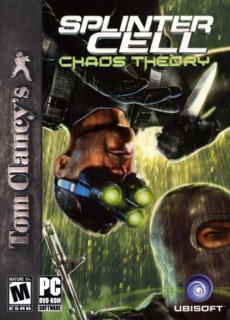Plenty of improvements make this a very respectable sequel.
+ All in all I felt the gameplay in Chaos Theory was a lot better than its predecessor. You still must rely on stealth throughout the game, but before each mission you have the option of whether to equip your loadoat for more of a stealthy approach (fewer bullets, more gadgets) or more of an action approach (more bullets, fewer gadgets). You also have a recommended loadout which balances both approaches. Although this doesn't fundamentally change the game, it at least gives you some variety. If you never use sticky cameras but you often run out of bullets then you at least have some way to enhance the game to fit your needs. You also have an audio gauge right below your light gauge which makes a tremendous amount of difference. Not only do you see how much noise you are making, but you also see how much ambient noise is being made around you. You can then judge how much noise you can make while still being masked by the surrounding noise. A lot of the gadgets return including the lockpick, sticky camera, ring foil, shocker, etc. One thing I did like was the inclusion of the optic camera in the action menu instead of in your inventory. This makes it a lot easier and quicker to peek at what's behind a door. Also, you now have the option to smash the door in if you see an enemy on the other side, effectively knocking them out. You also have a knife which is wonderful when you accidentally stumble upon an enemy (the knife will instantly kill the person if you are close enough). You still rely on darkness a lot and equipped with your two guns you can still shoot enemies directly or kill the lights to create your own darkness. Infrared cameras make an appearance, though, and sometimes darkness won't always work. The enemy AI also seemed improved. They will notice if a door was open when it wasn't before, a light is now on, a computer is turned off, etc. This forces you to cover your tracks and adds to the realism of the game. They also will use flashlights to search the darkness, so you can't just hide forever. And now an alarm is only triggered if an actual enemy encounters a body, instead of before where any body in a well-lit area could automatically trigger an alarm. Another new gadget employed is the wireless hacking device used for logging into computers from a distance. Also, you can now hack electronic doors and computers using a mini-game where you have to guess the correct number similar to an IP address. The level design was real impressive, taking you to all sorts of locations and letting you sneak around all sorts of buildings, headquarters, streets, and caves. There are also commonly at least two ways to get into some areas (either a stealthy ventilation access, or just walking in the main door brute-force fashion). Granted it's not as open as say Deus Ex, but at least it makes the effort. Finally, now you have main missions, secondary missions, and also some optional side missions that you can choose to go out of your way and complete. I liked the extra option to do more in the level if you feel like it, but I was kind of disappointed because I wished those extra objectives would affect different missions later on. Still, Chaos Theory was a lot of fun and was a fine example of a stealth game.
Story/Presentation: 3/5
+ Okay, the story is probably the one thing that falls short. It's a generic spy tale about saving the world, just like the other Splinter Cell plots. Parts of the story were confusing, sometimes it seemed like it jumped around, but at the same time it still managed to give some sense of thrill. I did like Sam's sarcastic banter whenever you interrogate an enemy and his wise-cracks seemed to fit his character well.
Graphics: 4/5
+ The graphics worked really well with the game. They're better than the original Splinter Cell, even if they seem dated 6 years later. The lighting again is a real focal point, and the animations are a lot better too. Still, the character faces seem skewed (especially when you grab an enemy from behind) and everything seems to be just a little too shiny and reflective (including the characters skin). But since most of the game you'll be using nightvision, everything looks and feels just fine.
Value: 4/5
+ I managed to complete the game in about 12 hours or so, which is decent for an action game. Sure, you create your own pace in the game and you can probably complete it faster or slower but it still feels like it offers plenty. Anything over 10 hours is a welcome for action games, so I wasn't disappointed. As far as replayability goes, the game does give you a percentage of how good you completed each level and by the end it reveals your final score. I never paid too much attention to these scores because I played each level how I wanted to play (and perhaps not to their standards). Regardless, it does give you some small reason of going back and trying for 100% if it interests you.

